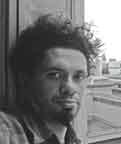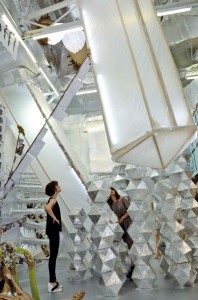« Features
Kettle’s Whistle / The Prodigal Son
In December 2003 Thomas Hirschhorn dropped a bomb in the room by announcing that he would no longer exhibit in his home country. The page-long statement was motivated by the election of Christoph Blocher, number two of the ultra-conservative Swiss People’s Party, to a full member of the Federal Council the very same year. “I cannot accept the newly elected Swiss Upper House of Parliament because nothing is more luxurious, nothing is more comfortable and nothing is more egocentric to be a democrat today,” roared the artist. “(…) In a few years, Blocher, as the highest government official, will represent Switzerland, MY COUNTRY (emphasis of the artist), and this I will not accept as a Swiss.”
Hirschhorn wasn’t new to similar initiatives. Three years earlier he had given his support to Austrian curator Robert Fleck, a French expatriate like Hirschhorn himself, when he fought the rise to power of Jörg Haider’s Freedom Party by calling for an international boycott of Austrian museums and institutions. While the practical effectiveness of such actions could be argued-the relevance of intellectual dissent on international politics is regrettably not as strong as its perpetuators would like to make out-the impact on the art world and those who gravitate around it was potentially damaging. Fortunately Susanna Kulli, Hirschhorn’s Swiss dealer at the time and possibly the one mostly penalized by this decision, was supportive, and Harald Szeemann, another figure sympathetic to Hirschhorn’s plea, invited him to participate to the first edition of the Seville Biennale with the half-jocular opening line, “I hope this doesn’t mean that you won’t work with Swiss curators as well.” Hirschhorn accepted.
As the hordes who recently signed the Free Ai Weiwei petition and flew to Art Hong Kong for business as usual the following week attest, there’s often a badly concealed sense of convenience behind these radical stances. Not that there aren’t good reasons. If the world’s most powerful nations can’t bring themselves to engage in a concerted refusal to deal with China over Human Rights infringements or Tibet occupation, why should a micro-economy like the art world? Cutting off America or Germany is one thing, but surely for an internationally exhibited artist with undisputed critical acclaim, ditching two relatively small-sized working fields like Switzerland and Austria doesn’t represent that big a deal, does it?
The fact is that Hirschhorn, who rightly loathes being depicted with vapid definitions like ‘Swiss Artist,’ is quite at home with the two ingredients of the broth when separated. He is Swiss. He is an artist. His sense of outrage at Blocher was expressed as a Swiss citizen, but art is a different matter. It is not a uniform. It’s a weapon. It enjoys a universal entity status, and it is, in what constitutes the most delicious paradox of the whole business, indeed a democracy, offering in principle the same degree of responsibility and involvement to all its practitioners, regardless of geographic provenance.
Hirschhorn actually didn’t limit himself to boycotting. “Swiss-Swiss Democracy,” his exhibition at the Swiss Cultural Centre in Paris in 2004, put theory into practice, attacking the ‘absurdity of direct democracy’ by openly destroying the image of his home country with graphic attacks on Blocher, national hero William Tell, and the three founding cantons of the confederations, depicted next to tortured Iraqi prisoners under the banner ‘I Love Democracy.’ If the tension level between the two camps up to that point had been green/amber, now it was nuclear red. The Swiss government identified Pro Helvetia as the culprit and went on to cut its funding, only to re-establish them a year later, involuntarily conceding that the decision, presumably taken in the heat of the moment, had been foolish. The mission, as far as it could go, was accomplished.
Hirschhorn eventually lifted his self-imposed ban in 2008, and things finally came full circle last fall when it was announced that he would represent Switzerland at the 54th Venice Biennale. His project, entitled Crystal of Resistance, refers to an episode the artist witnessed on the Furkapass glacier when he saw a group of children selling crystals found on the road. It’s a significative story, and it deeply resonates with one aspect of Hirschhorn’s work often overlooked: the innocent, childlike dimension of his installations. Walking around Hirschhorn’s cavernous environments is not just politically educational, visually disturbing, or conducive to reflection. It’s also fun. There’s an overwhelming sense of someone creating his own universe and rules, a dynamic not dissimilar to the one of a child playing. Both stances include the setting up of a microcosm where the author is the ultimate creator and rule-maker. The difference is that Hirschhorn’s own world is wide open, uncompromising but strangely inclusive. Can my work create a new term of art? Can my work develop a ‘critical corpus’? Can my work engage a ‘non-exclusive public’? These three questions are at the core of Hirschhorn’s present struggle for an art that is universal and capable of transformation. By publicly revealing his quest, Hirschhorn added a note of vulnerability to something otherwise fiercely militant and immovable. Crystal of Resistance transcends its national context to provide a unilateral welcoming experience, an attitude that visitors in Venice no doubt have been only too happy to reciprocate.
Michele Robecchi is a writer and curator based in London. A former managing editor of Flash Art (2001-2004) and senior editor at Contemporary Magazine (2005-2007), he is currently a visiting lecturer at Christie’s Education and an editor at Phaidon Press, where he has edited monographs about Marina Abramović, Francis Alÿs, Jorge Pardo, Stephen Shore and Ai Weiwei.




































